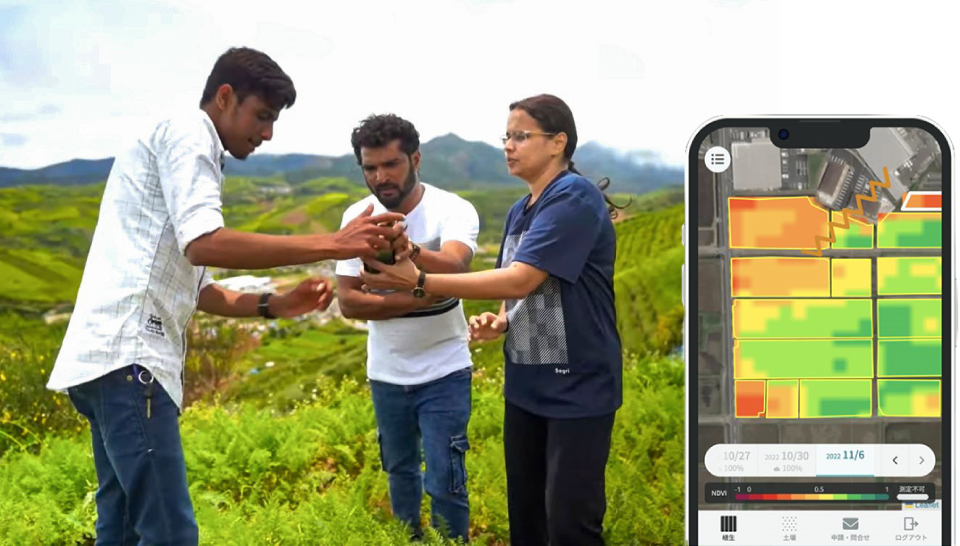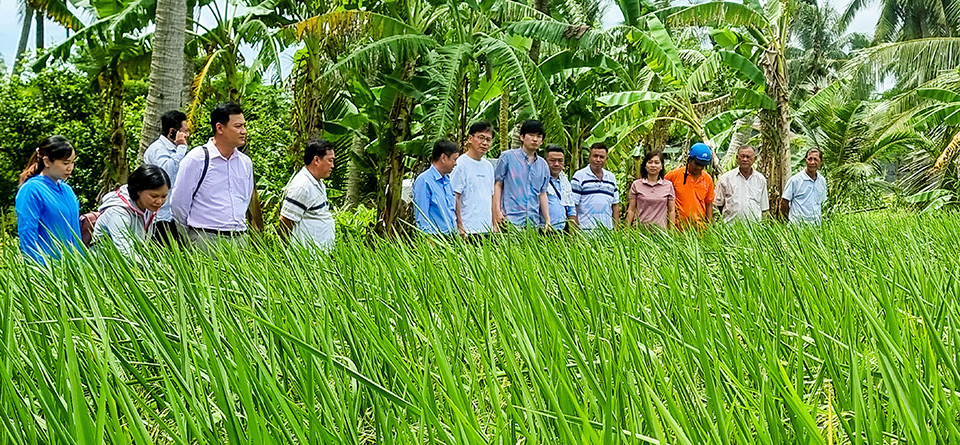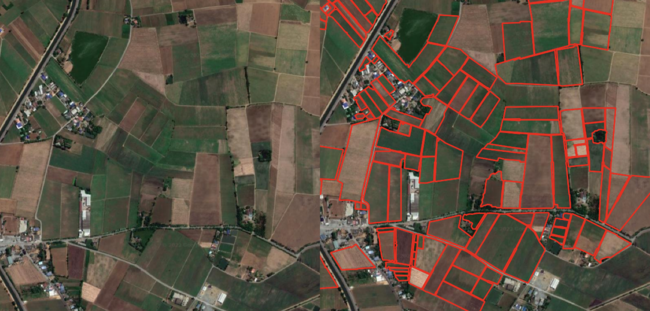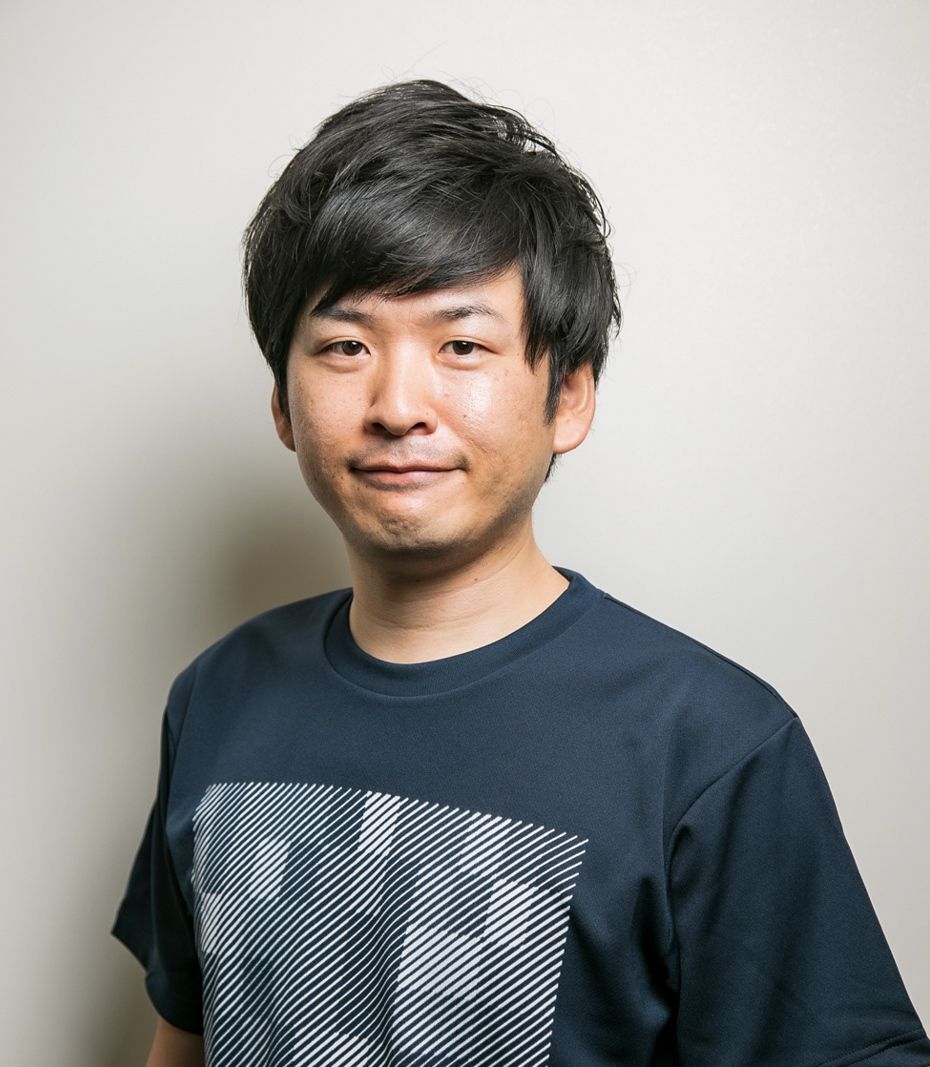Smart farming—the application of leading-edge technologies such as robotics and IoT to agriculture—is spreading around the world, not least in Asia. An example of this is an innovative Japanese technology that leverages satellite imagery and AI to enable even smallholder farmers to adopt data-driven agriculture at affordable costs.

With Sagri’s service, crop conditions and soil analyses for each individual farm can be confirmed by digital devices such as smartphones (right). “Up to now, such technologies were rarely available to smallholder farmers, so our service has had a huge impact on optimizing seed and fertilizer amounts,” said Chevdumoi Ravanth Mohanaram (on the right of the left photo), the COO of Sagri’s Indian affiliate.
Recent years have seen an acceleration in digital transformation (DX) in various sectors, including agriculture. While data-driven agriculture management is progressing in the United States and Europe—which mainly practice large-scale farming—innovative initiatives are also emerging in Japan and other Asian countries, where small-scale farms are the mainstream. One company driving the trend in Asia is Sagri Co., Ltd., a Japanese startup. Founded in 2018 with the goal of finding solutions to the world’s agricultural challenges, the company’s strength lies in its technology that uses satellite data and AI to automatically conduct sophisticated analyses and forecasts on farmland.
By having AI learn from massive amounts of “teaching data” combining satellite data and actual on-the-ground information on farmland, it will become able to arrive at the right answers on its own. Not only can the system make predictions about each parcel of farmland in terms of crop conditions and harvest yield, etc., but it can also analyze the soil, assessing the amount of nitrogen and carbon, pH values, and other conditions. As soil samples are normally required to make such analyses, the use of Sagri’s system can significantly reduce both cost and labor.
In addition to its domestic business, Sagri is working to introduce the system among ordinary farmers in India and Thailand following pilot projects to tackle the agricultural challenges in those countries. In India, more than 12,000 farmers are making use of Sagri’s soil analysis services, with some now able to reduce their chemical fertilizer consumption by nearly 20%. As this reduction helps to also reduce emissions of nitrous oxide, a greenhouse gas, it can result in qualification for carbon credits. To turn these credits into a new source of revenue for farmers, Sagri is now undertaking procedures to obtain the qualification to receive them. The company also plans to launch the same system in Vietnam, Cambodia, and elsewhere. “Carbon credits will be a great incentive for farmers, leading also to the decarbonization of the agriculture sector in emerging countries,” said SAKAMOTO Kazuki, who heads the company’s Asia business.

A farmland in Vietnam included in Sagri’s project. Surveys were conducted on such information as the amount of fertilizer used.
The foundation for such pioneering efforts is the farmland parcel in question. In agriculture, the size and shape of a particular plot of land, along with its unique conditions such as irrigation and sunlight, are the major factors in all decision-making, from what would make for the most suitable crops to how much fertilizer should be used. While that underscores the importance of delineating land parcels, in emerging countries, plots of land are not often delineated accurately. According to Sakamoto, “A land parcel represents, so to speak, the farmland’s ID, serving as the foundation of its link to important information and analysis.”

Farm parcels in Suphan Buri Province in central Thailand that have been automatically delineated using satellite imagery (indicated by the red lines in the right-hand image). That proves that even the boundaries of small-scale farms whose shapes are unique and irregular can be accurately mapped.
Sagri has developed technology for the accurate and automatic mapping of diverse types of farmland based on satellite data. First, it provided AI with the vast amounts of information on farmland available in Japan, which includes many small-scale farms. The accuracy of the technology was then further enhanced by providing the AI with information about farmland in India, the company’s first overseas business destination. “India’s farmland is truly diverse in size and shape. Thanks to these inputs, our AI can now identify various kinds of farmland,” said Chevdumoi Ravanth Mohanaram, the COO of the company’s Indian affiliate. Also, when used in a pilot project in Thailand that was selected in 2020 to promote a project under the Japan-ASEAN Asia Digital Transformation Promotion Program, the system was highly acclaimed for being able to accurately delineate Thai farmland, which can be narrow and rolling.
In its business overseas, nothing is more important to Sagri than working with partners who are well-versed in local circumstances and culture. In Thailand, the firm has been developing a soil analysis model together with researchers at the Faculty of Agriculture, Kasetsart University, and a soil analysis project is now being prepared for launch with Bangkok Produce Merchandising, a subsidiary of the Charoen Pokphand Group, Thailand’s largest conglomerate, aiming for social implementation. “We would like to work together with local people, rather than impose our technology or values on them. And the day will eventually come when we pass the baton to them, and they will manage the system’s operations on their own,” stated Sakamoto.
This novel approach to agriculture, developed jointly with local partners, should bring about further growth and an inclusive, mutually rewarding future.

“If smallholder farmers can stabilize their income through data-driven agriculture, their children will have the means to receive an education and the chance to pursue their aspirations. It is our dream to create such a future,” said SAKAMOTO Kazuki, who heads the company’s Asia business.






























